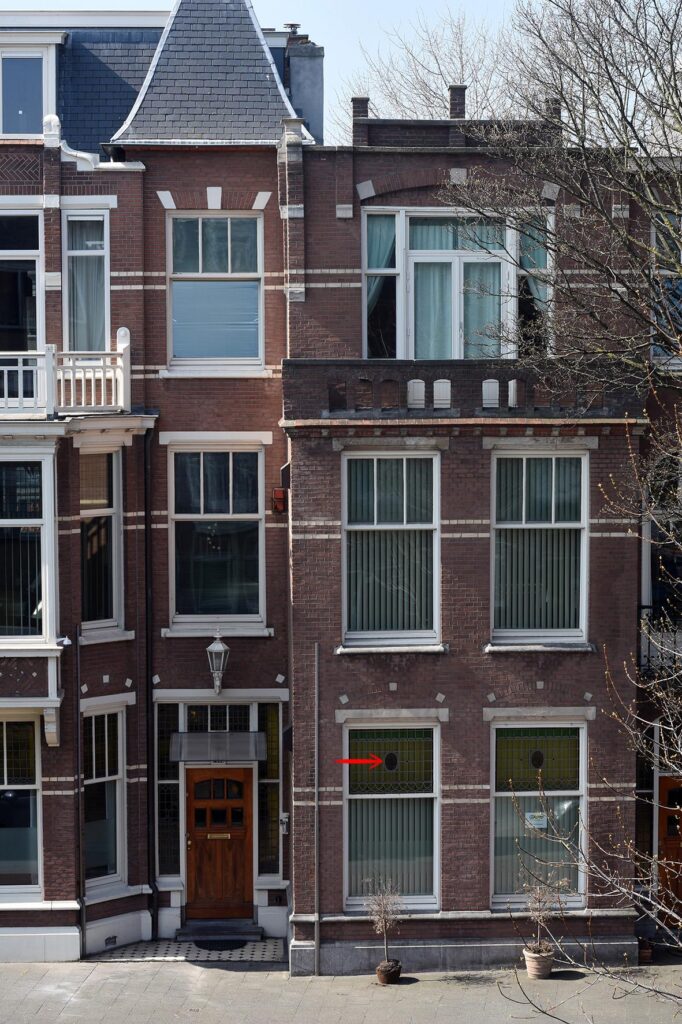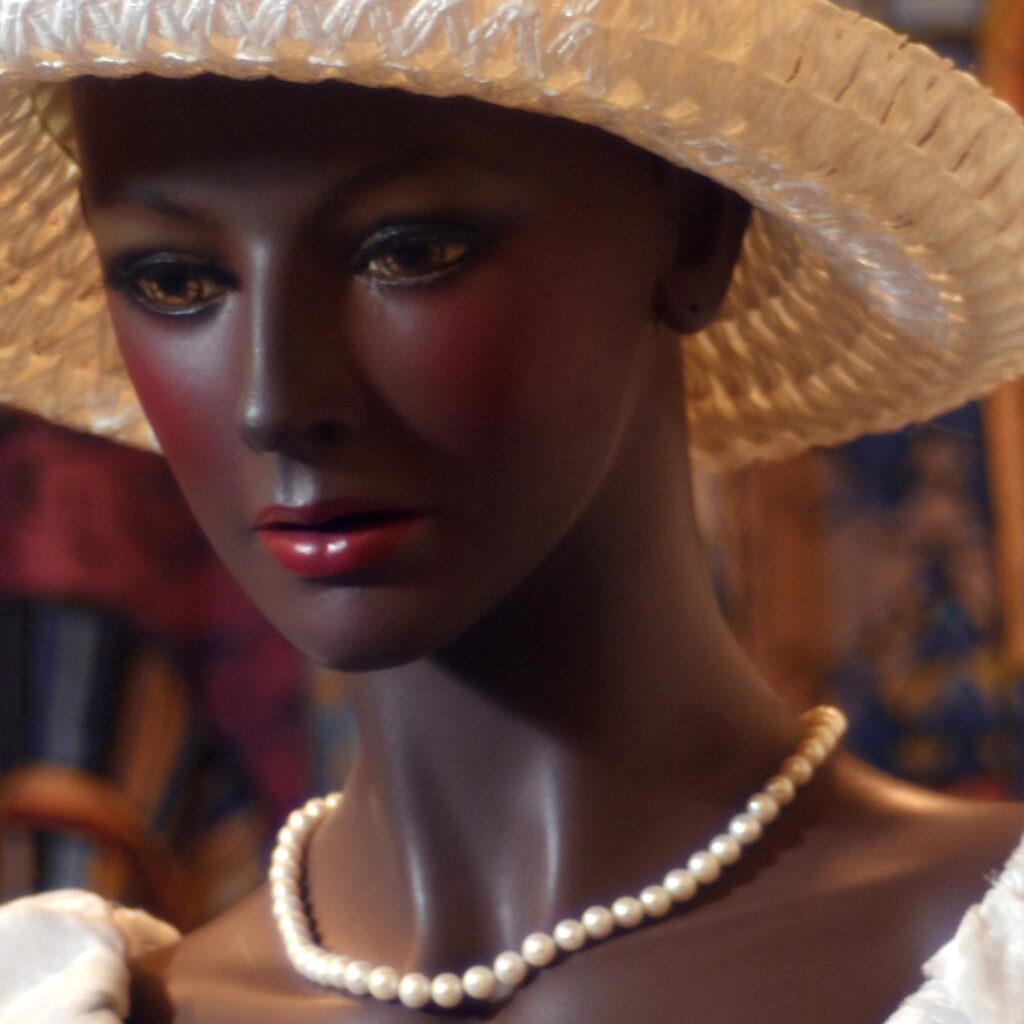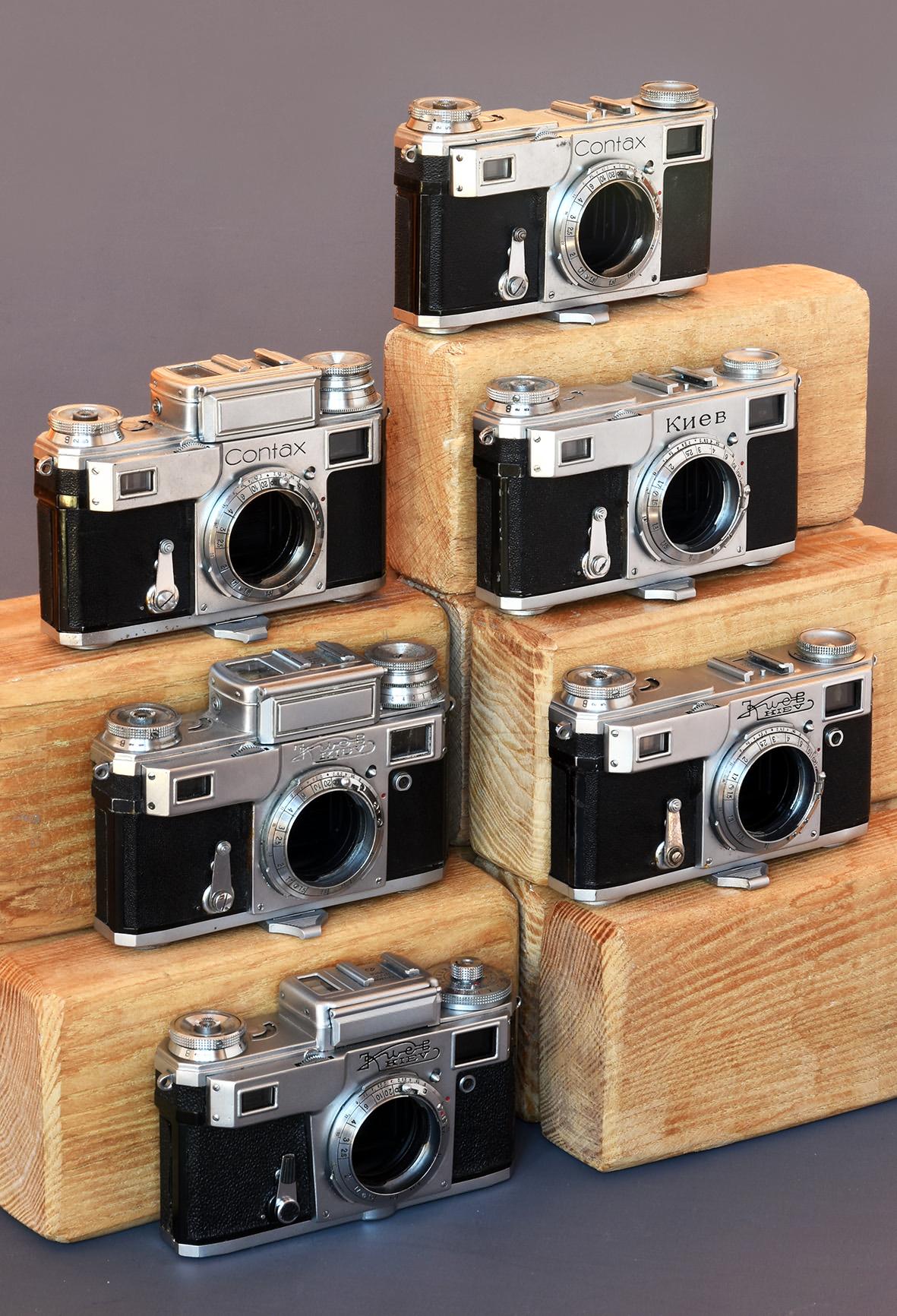The city of Kyiv has a rich photographic tradition. There are also international relationships between cameras from Kyiv and German and Swedish manufacturers such as Carl Zeiss Jena, Pentacon and Hasselblad. I’ll dwell on this briefly. Then I will put a spotlight on a camera, the Salyut-S from the 1970s. This isn’t just a cheap alternative to the real thing. Precisely because of its different design, this camera offers creative possibilities without fuss.
Cameras from Kyiv: A Contax
A logical start is the rangefinder Contax, which was made on a German production line in Kyiv shortly after the war. Without a doubt, this history is worth a separate article. A family photo should suffice here. It is easy to see that the first cameras built in Kyiv correspond in detail to the pre-war Contax. Initially, the main difference was in the nameplate. Somewhat later, the Cyrillic nameplate was replaced by a nameplate with a combined Latin KIEV and Cyrillic КИеВ engraving. Another notable change was the addition of a flash contact on the front of the camera body. The Kyiv-Contax was in production until the mid-1980s.
Cameras from Kyiv: With Pentacon-Six bayonet
A second example of international cooperation is cameras such as the Kiev-88 and the Kiev-60, which use the East German Pentacon-Six bayonet. Modern versions of these cameras (the Arax) are still being made in Kyiv. There are even custom-made outfits in many colours and textures. I owe the example pictures to Gevorg Vartanyan.

Because of the Pentacon Six bayonet, the beautiful zebra lenses from Carl Zeiss Jena can be used on these cameras. The overview photo shows these lenses in combination with a Kiev-60 camera. The Kiev-88 is (except for the bayonet) largely identical to the Salyut-S to be discussed below.
The Salyut S – Hasselblad
In this article, I want to give some more attention to the Salyut-S Cyrillic: САЛЮТ-С. This camera is clearly derived from the first Hasselblad with a focal plane shutter and screw bayonet. With the later Hasselblad models, each lens has its own built-in lens shutter. This has great advantages for studio photography because you can use the flash with any shutter speed (up to 1/500 sec.). With the Salyut-S’s focal-plane shutter, the fastest flash synchronization takes place at 1/30 second.
There are also drawbacks to the advantage of the Hasselblad. It is expensive to give each lens its own shutter. It is not possible to use lenses and/or accessories from other brands on a Hasselblad. And it’s almost impossible to fabricate one’s own lenses and/or accessories. For a professional photographer, these objections carry little weight. For a hobbyist with a much smaller budget, they are quickly decisive.
Salyut-S with original lenses and accessories
A major advantage of the Salyut system is the affordability of the individual components. New and used, you can start small and expand step by step. You don’t have to be ashamed of the quality.

Unfortunately, the Salyut-S does not have a built-in self-timer. So for the group photo, I had to use an external self-timer. That’s a nice piece of mechanics, and the audience really appreciated the demonstration beforehand. All eyes were on the spinning red dot of the self-timer. That works much better than “Say cheese”!
Cameras from Kyiv: Creative Applications
Apart from the affordability of individual lenses and accessories, the Salyut system has a second advantage. That is the creative space that arises because the camera already has a built-in shutter. I would also like to show you some examples of this.
Rodenstock Imagon
One reason for embarking on the Salyut system was that I could easily adapt a pre-war Rodenstock Imagon lens (f=120mm) to the Salyut bayonet. In the literature, this is the soft focus lens par excellence. It immediately provided an additional focal length compared to the 90mm standard lens and the 150mm telephoto lens. Working with this beautiful lens does require practice. I need to get a lot more experience with this!
Cameras from Kyiv: Meyer Trioplan lens
Another lens famous for its ‘bokeh’ is Hugo Meyer’s Trioplan. This lens is now very popular for digital photography as well. At a Fotografica fair, I came across a cheap version, an f/3 f=100mm, which was designed for projection purposes. But why wouldn’t it be suitable for photography as well? I glued the lens in a Salyut extension tube. Unfortunately, the lens is too far forward in the mount, so I can’t get a sharp focus at infinity. This can be remedied with a negative conversion lens (Distar) of the correct strength. In this case, 2 dioptres proved to be sufficient. In this way, the focal length becomes 2.5cm longer (from 100 to 125 mm).
Some explanation may be useful here. Dioptre units can be added and subtracted. A 100mm lens has a power of 10 dioptres (1000/100 = 10). In combination with a negative conversion lens of -2, one gets a value of 8. This corresponds to a focal length of 125mm (1000/8 = 125). Due to the longer focal length, the relative aperture decreases somewhat: from f/3 to approximately f/4.
Cameras from Kyiv: Enlarger lenses
Enlarger lenses are also suitable for photographic purposes. Of course, they are designed for the near area. And naturally, a 35mm enlarging lens is not suitable for a 6×6 camera. But I don’t see any reason why a 9x12cm or 4×5″ enlarging lens would not provide a nice portrait lens for the 6×6 format.
So I put it to the test by combining a defective Salyut lens with an f/4.5 f=150 Schneider Xenar enlarging lens. I was very pleased with the result. One reason is the great saving in weight compared to the very heavy f/2.8 f=150mm Calejnar. A second reason is that small filter sizes are considerably more common than size 82!
Cameras from Kyiv: Bellows and tubes
In 2017 I bought a second-hand bellows in Budapest that had already been made suitable for the Salyut-S. I adjusted the lens connection myself and made in addition the wooden tripod mount. The aforementioned enlarging lenses combine very well with this bellows. Thanks to the long bellows extension, one gets extensive options in the close-up range.
Another application is working with close-up filters. In the example, I combine two achromatic close-up lenses of 1.6 dioptres each. This combination has a power of 3.2 dioptres, which equates to a lens with a focal length of approximately 300 mm (1000/3.2 = 312 mm). With filter size 52, the lens opening is approximately 50mm wide. This produces a relative lens opening of f/6 (300/50 = 6).
Tubes are suitable for close-up photography as well. Another use is to combine several tubes so as to make a very long focus lens. The picture shows a combination of tubes (Pentacon-Six, Salyut-S and Praktina) with a focussing unit (the empty barrel of a defective lens). The total length matches the focal length of the close-up lens. In this case, 1,6 dioptre, which is equivalent to an f=625 mm lens. In combination with a 2x converter, this would even yield an f=1250mm lens. However, inspection on the ground glass shows heavy vignetting.
Adding a second close-up lens increases the power of the optical system and reduces the focal length. This means that a shorter tube will do. Adding or removing tubes has a similar effect as sliding the lens carrier along the rails of the bellows unit.
Cameras from Kyiv: Adapters
Different adapters are available for the Pentacon-Six and Salyut bayonet. One adapter makes it possible to place Salyut lenses on a Pentacon-Six mount. Other adapters bridge the Pentacon-Six and Salyut bayonet to, for example, M42 (Praktica, Pentax), Exakta, Canon EOS and Nikon F. In fact, all the lenses discussed here can be used via an adapter on a digital body.
Cameras from Kyiv: From 6×6 to digital
That being said, I have to provide an illustration. For this, I combine the aforementioned 300 mm lens with a half-frame Nikon 7200. The picture was taken at full aperture (f/6). The 50mm standard lens of the Nikon F2 (at f/11) serves as a benchmark for comparison. This shows that the 300mm lens does indeed magnify a factor of six. I find the quality surprisingly good! This is undoubtedly due to working with achromatic close-up lenses. With regular close-up filters, there will be less sharpness and more atmosphere.
The second example is the f/12 f=625mm long-focus lens, which consists of a single achromatic close-up lens. This can be combined with a 2x converter so as to obtain a 24/1250 lens. This combination would lead to vignetting on a 6×6 cm negative. But since a half-frame digital sensor is much smaller (about 16x24mm) this problem does not occur now. Undoubtedly, a digital 1250mm lens will be sharper. But with such simple means, the quality of the image is surprisingly good.

The third example is the previously mentioned Trioplan projection lens by Hugo Meyer. I made a portrait picture with this lens at full aperture in combination with a Distar conversion lens of -2 dioptres. For comparison, I made a second picture with a Vivitar Series 1 70-210 zoom lens at aperture f/4. At small enlargements, the difference is hard to see. So I enlarged two square sections. The Vivitar is clearly the sharper lens. But I feel the Trioplan, with its softer rendering, is more than a match!

Cameras from Kyiv: Conclusion
The cameras from Kyiv have common ground with historical, geopolitical and photographic subjects. The Kyiv-Contax, for example, once started as a reparation payment for the suffering caused during the Second World War. This subject is painfully topical today.
Photographically, cameras from Kyiv offer an affordable entry into medium-format photography. They are mechanical, manually operated cameras with an open system. The photographer is free to experiment with homemade solutions, combining economy with creativity and fun. We have a lot to be grateful for. That’s why this article is for Kyiv. With love.
Visit the website of the Photographic Collectors’ Club of Great Britain (PCCGB) for more information on a wide range of vintage photographic equipment.
Want to contribute an article to Macfilos? It’s easy. Just click the “Write for Us” button. We’ll help with the writing and guide you through the process.






























I recall the Salyut S was based on the early Hasselblad 1000 so not compatible with the 500 series and later. The Kiev 88 and Zenith 80 were similar models.
Quality control was always an issue with Soviet camera. Apparently TOE the UK importers quality checked all cameras before resale.
Very interesting article. I used to own the Kiev 88 aka. the Hasselbladski. They were dirt cheap at the time and I actually regret selling mine.
Hi,
“..It is easy to see that the first cameras built in Kyiv correspond in detail to the pre-war Contax..” ..we-ell, they LOOK similar ..but you don’t mention the differences in quality of manufacture between the German-built (..or Swedish-built..) and the Kyiv-built cameras.
I’ve used these Kyiv-built copies ..and other Russian ‘copy-cat’ cameras like the Zenith SLRs and the FED and Zorkii Leica copies.. and (..I’m sorry to have to say this..) the workmanship is terrible: sharp, unsmoothed edges which cut into your hands, sticky shutters which fail to close, poorly made cog wheels which grind against each other instead of winding smoothly, etcetera. (FED cameras were assembled in Kharkhiv, Ukraine, by children and adolescents, not trained engineers, so there’s little surprise that they don’t compare well to the standards of the originals.)
The lenses are though – for the most part – pretty good, but the camera bodies are rather poorly made. Imagine a Rolls-Royce copy which looks like the original, but is fitted with a Trabant engine ..you get the idea.
Churning out copies with the appearance of the original item is all well and good ..but if they don’t have the performance of the original (..think of counterfeit Rolexes, say..) then what’s the point? ..It was to bring in plenty of post-war ‘western’ cash to Russia.
Japanese copy-cat cameras, on the other hand – the early ‘Kwanon’ Leica copies, which became ‘Canons’; the early Chiyodas which became Minoltas – were not just lookalikes, but were assembled with real attention to how well they worked, not just how they looked. Having used all sorts of eastern European and Russian cameras – most were imported into the UK by Technical and Optical, who had a shop on Holborn in London – though extraordinarily cheap, I think they’d last about six months – if that – and then break, jam or otherwise fail.
It’s interesting to read about these eastern European versions of established brands, and to see some of the photos taken with them, but as day to day workhorse – or even occasional-use – cameras, my opinion is that, for the most part, they were as useful as chocolate spanners: OK for learning the basics of photography, but for not much more than that.
On the other hand, your own various home-made lens assemblies are really enterprising, inventive and accomplished ..though I don’t think I’d want to carry that Salyut-S with its elephantine home-brew 625mm or 1250mm lens!
The Ukrainian and Russian lenses of the post-war period are generally very contrasty, compared with many west European lenses, but do flare a bit without the Zeiss T* ‘secret sauce’ coatings, and can certainly hold their own against many Leica and Contax offerings ..except, perhaps, for their mechanical construction. Optically, though, they’re generally really good!
Many thanks for your review of Kyiv-made photographica!
Great article Roland and lovely story William.
There is so much interesting photographic history!
All the best
Good to see your article on here, Roland. I think i have mentioned Arthur Fields (Abraham Feldman) 1901-1994 aka ‘The Man On The Bridge’ to you before. His family had fled antisemitism in Kyiv in 1885 and eventually came to Dublin. For most of his life he was a commercial street photographer on O’Connell Street and Bridge in Dublin and his modus operandi was similar to that of the British seaside ‘walkies’ photographers. He would photograph people on the street, hand them a ticket and they could collect the photos the following day. He walked a 7 mile round journey every day and his wife developed the photos at night in a darkroom under the stairs in his house, but not before she had cooked him some kippers for his supper.
The relevance of this to your article is that there is a famous picture of Arthur, of Ukrainian Jewish descent, standing on O’Connell Bridge in the 1950s with a ‘Kiev’ camera around his neck. Arthur used a Polaroid camera in his declining years when he was very frail and the wind coming up the River Liffey seemed to threaten to blow him into the river.
His memory is not lost and he has been the subject of two books and a television documentary about his life and work. There is also a website which can be found through the Wikipedia entry about Arthur Fields (Photographer). People sent in thousands of photographs taken by Arthur for the project about him. These photos show many people just on a day or night out in Dublin and also some famous people such as George Harrison (of the Beatles) aged about 10 or 11 in Dublin on a trip to see his Irish cousins, who went to the same school that I did.
it is a long way from Kyiv to Dublin, but tens of thousands of Ukrainians are now in Ireland. I wonder how many of them will become professional photographers here? We certainly have met quite a few at Photo Museum Ireland, but Arthur’s photographic life is not likely to be repeated.
William